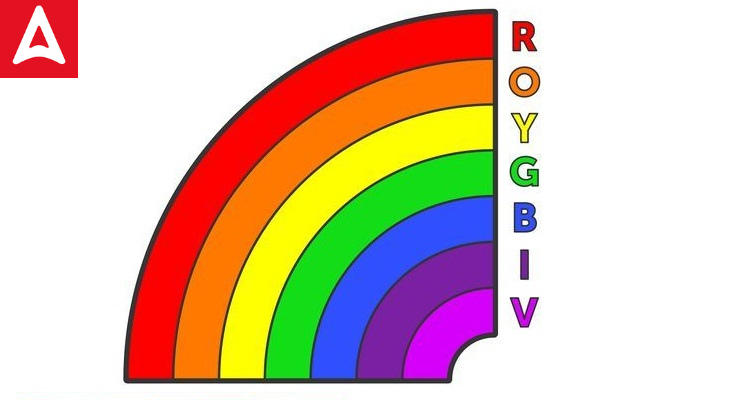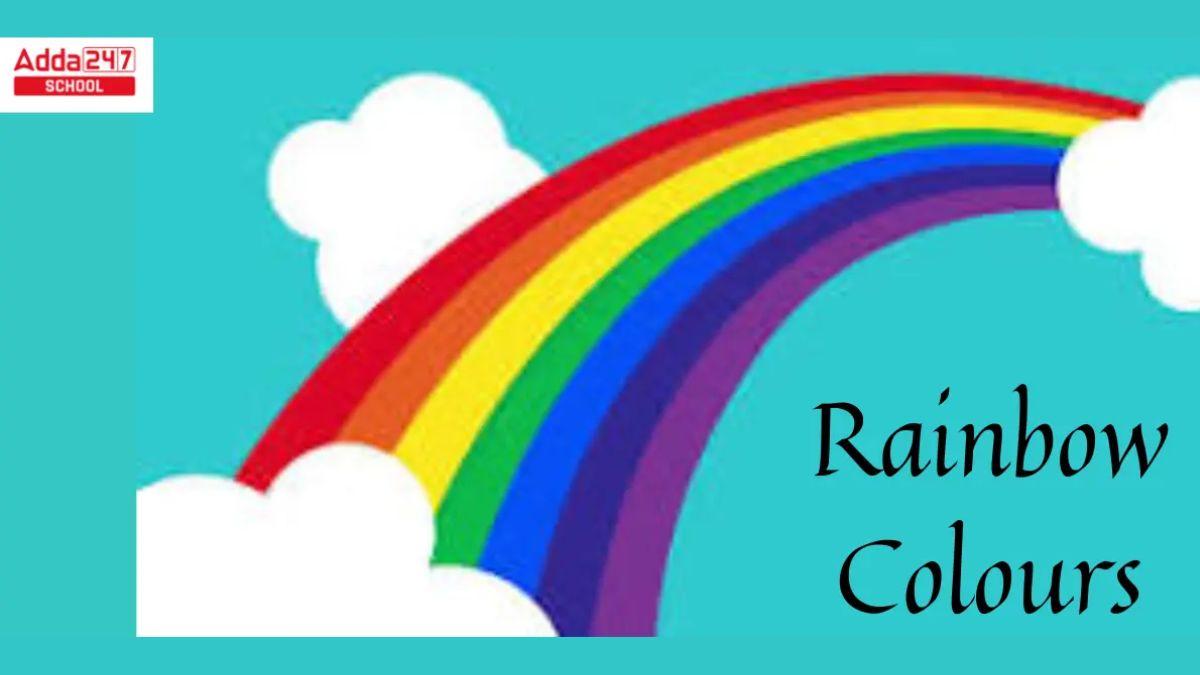Table of Contents
A Rainbow is a multicolor curve that occurs in the sky after rainfall. It is a result of reflection and refraction between sunlight and water drops. When the sunlight passes through the water drops or the rain, the light gets refracted and the droplets reflect it from the surface, as a result, it gets refracted at different angles.
The different colours we see in a rainbow colors is due to different wavelengths of light, as the light gets refracted in many angles, all the angles form different wavelength resulting in the distribution of different rainbow colours.
Rainbow
Rainbow is derived from the word ‘Renboga’ which is an old English word. It is made of two words ‘regn’ which means rain and ‘Boga’ which means curve, bent, or arched.
Why Rainbows are so fascinating?
Rainbows are very special and attractive. It is a wonderful creation of nature that fascinates people. All age groups, kids, youngsters, elderly people, everybody loves to see a rainbow after a rainy day. It is all about the beauty and rareness of the rainbow that makes it more special. People find it lucky if they get to see a rainbow. There is also a rainbow thing called double rainbow which is very rare and it is said that there are two rainbows in the sky at the same time. Isn’t it fascinating!
Rainbow Colours
A rainbow forms when sunlight passes through raindrops, splitting white light into its component colors through refraction and dispersion. It typically appears as a multicolored arc with seven distinct hues: red, orange, yellow, green, blue, indigo, and violet. These colors, arranged in this specific order, are often remembered using the acronym ROYGBIV. Red, being the longest wavelength, appears on the outer edge, while violet, with the shortest wavelength, appears on the inner edge. The phenomenon occurs when light enters and exits water droplets, bending at different angles to create the vibrant spectrum visible in the sky.
Rainbow Colors in Order
The colors of the rainbow in order are: red, orange, yellow, green, blue, indigo, and violet (ROYGBIV). While considering the colours name from the bottom, it forms the acronym VIBGYOR because the rainbow colours in this case are in the order: Violet, Indigo, Blue, Green, Yellow, Orange, and Red.
7 Rainbow Colours Name in Order Drawing
The 7 colors of the rainbow, in order, are:
- Red
- Orange
- Yellow
- Green
- Blue
- Indigo
- Violet
These colors are often remembered with the acronym “ROYGBIV.” This below given drawing will help us to better understand the colors order.

7 Colors of Rainbow in Order in Details
We all know, there are 7 colors of rainbow in order, and we find it difficult to remember all the seven rainbow colors. There are a few short forms you can use to remember like VIBGYOR, which is one of the most used ones. Some people also use ROYGBIV, just the reverse of VIBGYOR for rainbow colors.
The 7 Colors of Rainbow in Order are-
- Violet
- Indigo
- Blue
- Green
- Yellow
- Orange
- Red
You must be wondering why we do not see all these colors at once or why we do not see all the seven colors of the rainbow?
We do not see all the seven colors at once because we see the rainbow from different angles and it is not possible that the light gets reflected in that particular angle. As mentioned above, the wavelength of the light reflects the color and the wavelength depends on angle. Therefore, we all see a different rainbow from our point of view because it is from different angles.
Rainbow Colors- Vibgyor Meaning
Rainbow colors Wavelength is the distance from one crest to another or one trough to another trough of a magnetic wave or electromagnetic wave or sound wave.
Different rainbow colors have a different wavelength, all the colors in a rainbow have different wavelengths.
Colours of Rainbow- Vibgyor Meaning
- Violet: 380–450 nm
- Blue: 450–495 nm.
- Green: 495–570 nm.
- Yellow: 570–590 nm.
- Orange: 590–620 nm.
- Red: 620–750 nm
Here, violet has the lowest wavelength and red has the highest wavelength, which means violet has the highest frequency, hence higher energy, and red has the lowest frequency, hence low energy. This is because the wavelength is inversely proportional to frequency. Indigo does not have any wavelength.
How Many Colours of Rainbow?
There are 7 rainbow colours present. Rainbow not only increases the curiosity of people now but for many and many years rainbow has been a topic of investigation for scientists. People were always curious about the mystery of the rainbow with many questions like, from where does the rainbow arise, where does it vanish after some time, why we see colors, why it comes after rain? Etc.
These questions were slowly and steadily researched, studied, and experiments and now people get to know more about the rainbow. It is all about the science behind the creation of the rainbow. From all the researchers and scientists, Issac Newton was the first scientist who understood and put light on the rainbow theory. He did this by experimenting several times, his main objective experiment was to pass white light through a clear prism, and then when the white light reflected and got refracted again by the surface of the prism, there were several colors from which he named the most prominent seven colors of the rainbow.
Rainbows are one of the most beautiful and fascinating things we see as a child and it stays with us forever, even if we know why it is created and what is their origin, a child in our heart will always try to find the different colors and the end of the rainbow. There are many things we still do not know about the rainbow, and there are many people who are still researching and experimenting to get a new turn after Newton in the rainbow theory.
Seven Colours of Rainbow in Hindi
इंद्रधनुष एक बहुरंगी वक्र है जो वर्षा के बाद आकाश में होता है। यह सूर्य के प्रकाश और पानी की बूंदों के बीच परावर्तन और अपवर्तन का परिणाम है। जब सूरज की रोशनी पानी की बूंदों या बारिश से गुजरती है, तो प्रकाश अपवर्तित हो जाता है और बूंदें इसे सतह से परावर्तित कर देती हैं, परिणामस्वरूप, यह विभिन्न कोणों पर अपवर्तित हो जाती है। इंद्रधनुष के रंगों में हम जो अलग-अलग रंग देखते हैं, वह प्रकाश की विभिन्न तरंग दैर्ध्य के कारण होता है, क्योंकि प्रकाश कई कोणों में अपवर्तित हो जाता है, सभी कोण अलग-अलग तरंग दैर्ध्य बनाते हैं जिसके परिणामस्वरूप विभिन्न रंगों का वितरण होता है।
इंद्रधनुष के सात रंग हैं-
बैंगनी
नील
नीला
हरा
पीला
संतरा
लाल
Colours of Rainbow- All Facts
Rainbow colors are generated through the phenomenon of the dispersion of light. When light passes through a prism or a droplet of water, it is refracted or bent, and different colors of light are separated and spread out into a spectrum.
This happens because different colors of light have different wavelengths, and as they pass through a medium (like water droplets or a prism), they are bent at slightly different angles. This causes the different colors to spread out and become visible as a band of colors.
The seven colors of the rainbow are red, orange, yellow, green, blue, indigo, and violet, and these colors appear in a specific order because they have different wavelengths. Red light has the longest wavelength, followed by orange, yellow, green, blue, indigo, and violet, which has the shortest wavelength.
When we see a rainbow in the sky, it is caused by the refraction and reflection of light in raindrops. The sun’s light is refracted as it enters the raindrop, and then it is reflected inside the drop and refracted again as it exits. This causes the different colors to separate and create a circular band of colors in the sky.
Colours Names in Alphabatic Order
Here are some common color names listed in alphabetical order:
- Amber
- Aqua
- Beige
- Black
- Blue
- Bronze
- Brown
- Burgundy
- Cerulean
- Charcoal
- Chartreuse
- Crimson
- Cyan
- Emerald
- Fuchsia
- Gold
- Green
- Indigo
- Ivory
- Lavender
- Lime
- Magenta
- Maroon
- Navy
- Olive
- Orange
- Peach
- Pink
- Purple
- Red
- Rose
- Silver
- Teal
- Turquoise
- Violet
- White
- Yellow
This list can be expanded with more specific shades, but these are some common colors sorted alphabetically!



 CBSE Class 12 Physics Viva Questions wit...
CBSE Class 12 Physics Viva Questions wit...
 BSc Physics Syllabus 2025: Check Year Wi...
BSc Physics Syllabus 2025: Check Year Wi...
 Physics Investigatory Project Class 12: ...
Physics Investigatory Project Class 12: ...






























